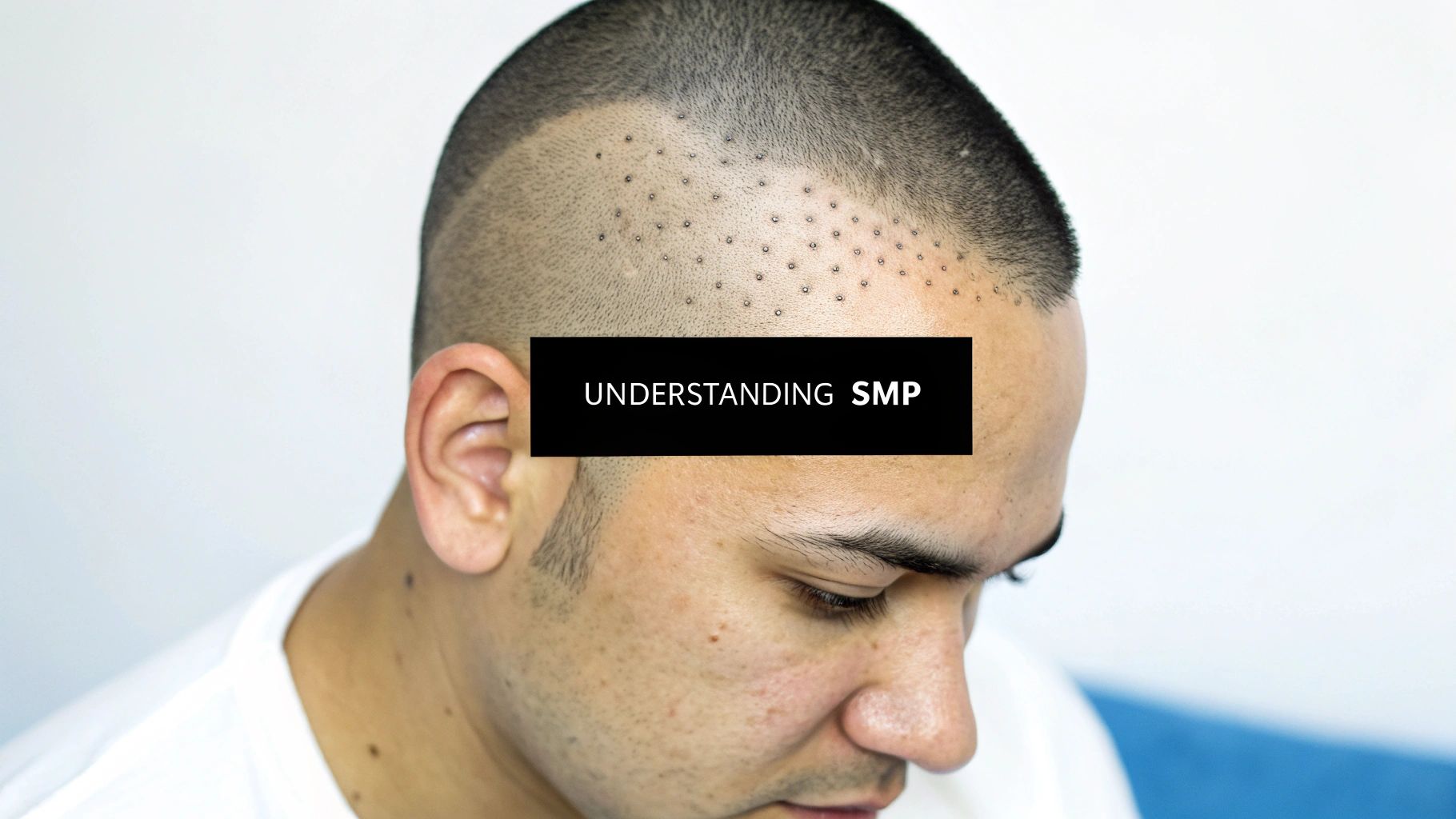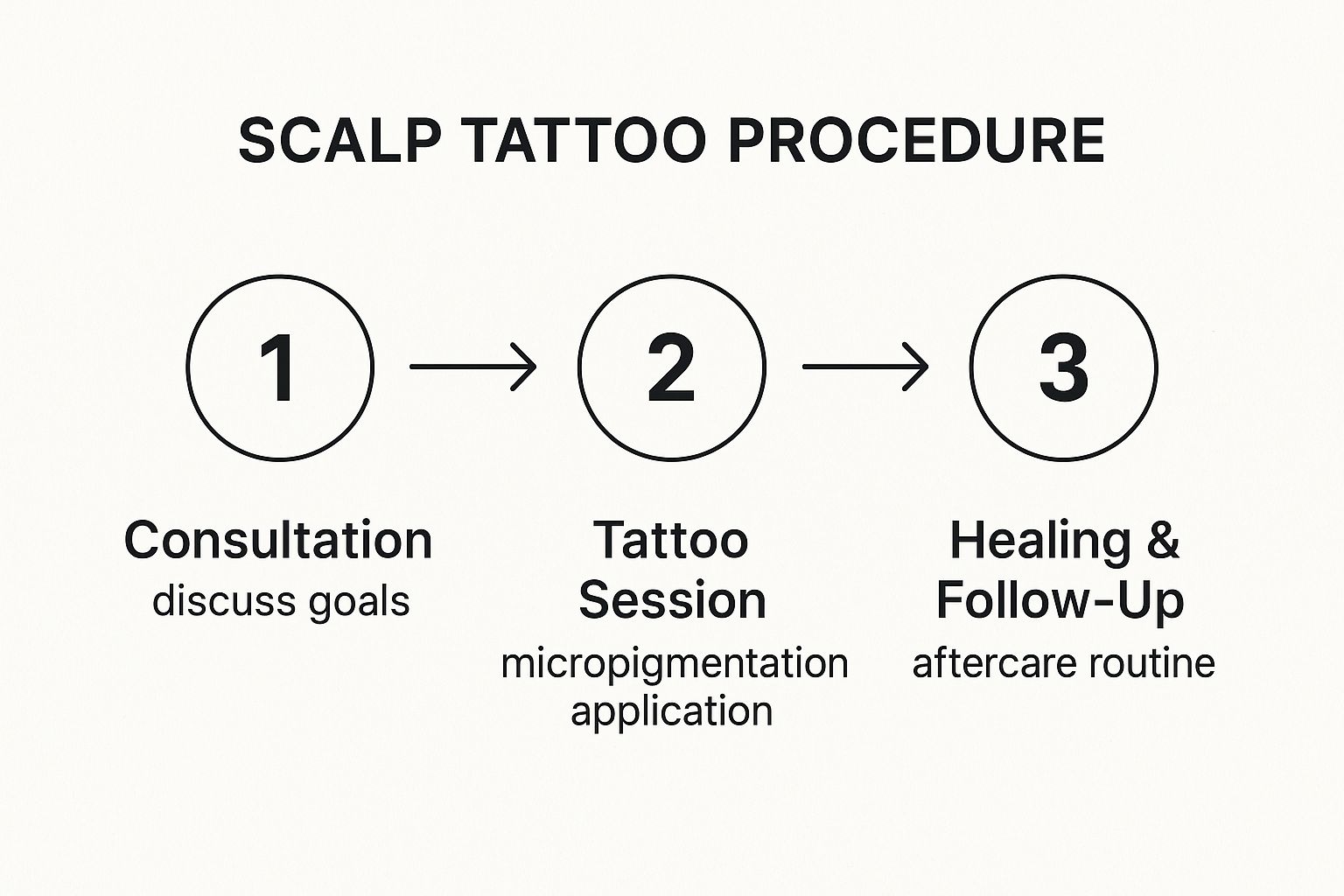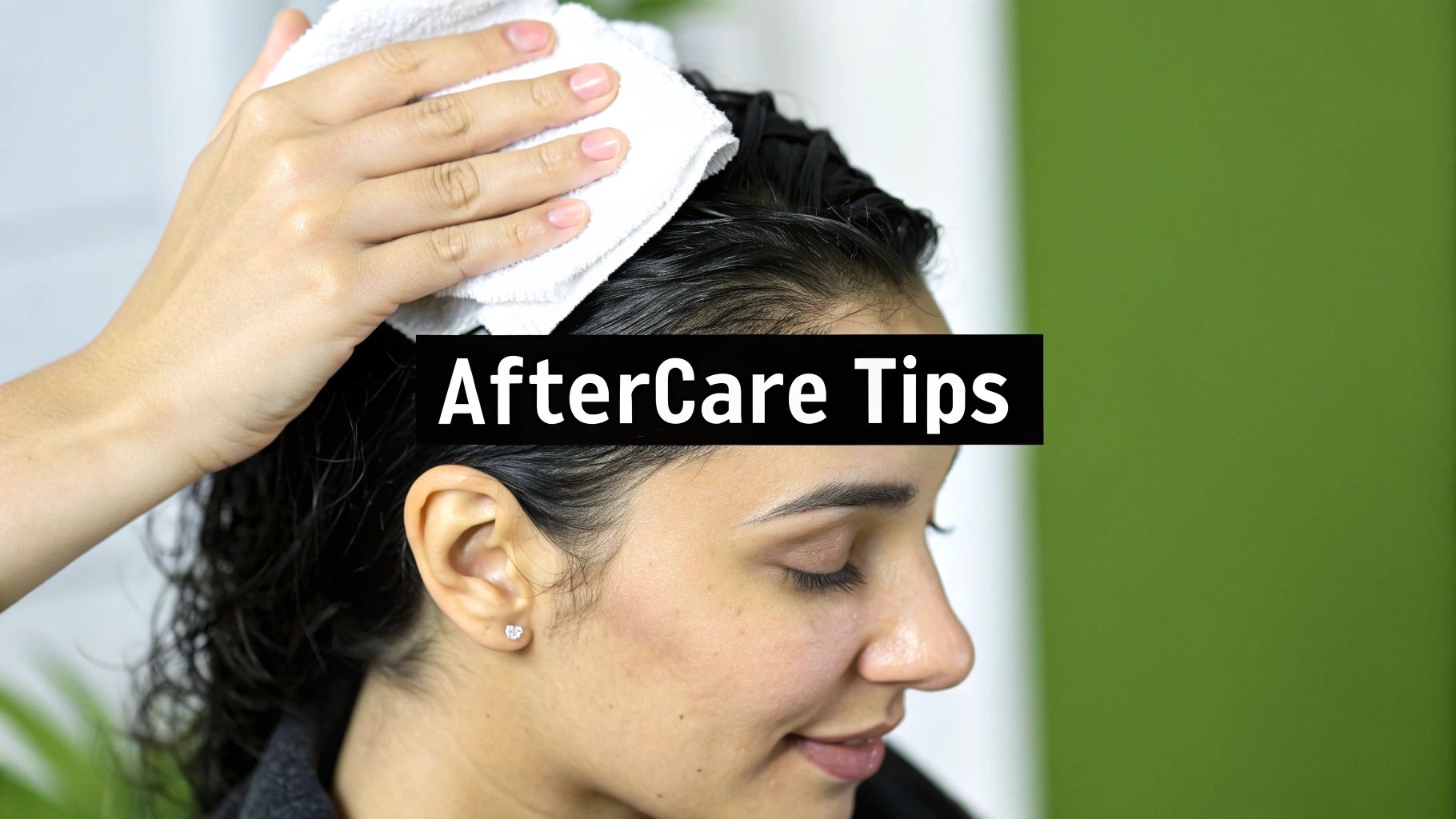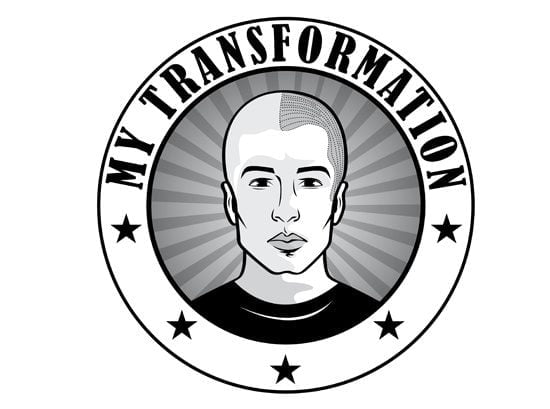
Head Tattoos for Hair Loss: Discover Your Best Solution
Share
Staring at a thinning hairline or a growing bald patch in the mirror can be a daily source of frustration. For many people, a highly effective and popular solution is a specialised cosmetic procedure you might hear called a head tattoo for hair loss. The technical term, however, is Scalp Micropigmentation (SMP). It’s important to know this isn't a traditional tattoo at all, but a very precise technique designed to create a convincing illusion of a full head of hair.
What Are Head Tattoos For Hair Loss?

When you first hear "head tattoo," your mind probably jumps to the bold, artistic designs you'd see in a regular tattoo parlour. But in the world of hair loss solutions, the reality is far more subtle and sophisticated. Scalp Micropigmentation is less about making a loud statement and more about crafting a masterful, understated illusion.
Think of it like artistic pointillism, but for your scalp. A highly skilled technician uses microneedles—much finer than standard tattoo needles—to deposit tiny, layered dots of pigment into the upper dermis of your skin. Each dot is meticulously placed to replicate a single hair follicle.
By strategically placing thousands of these micro-dots, the practitioner builds up a picture of density. For someone who is completely bald, this creates the undeniable appearance of a sharp, clean-shaven buzz cut.
The whole process really is a blend of art and science. Your practitioner needs a keen artistic eye to design a hairline that not only looks natural but also suits your face shape and age. On top of that, they need the technical precision to execute the treatment flawlessly, ensuring every dot is perfect.
Restoring More Than Just a Hairline
Ultimately, the goal of SMP goes beyond just camouflaging baldness. It's about restoring a sense of completeness and putting you back in control of your appearance. This is a huge reason why these head tattoos for hair loss have become such a sought-after solution here in Australia and around the globe.
The benefits are both practical and deeply personal:
- A Natural Look: When performed by a true professional, the results are incredibly realistic. The pigments are custom-blended to match your natural hair colour and skin tone, making the treatment virtually undetectable to the naked eye.
- Immediate Results: Unlike hair transplants, which involve a long wait for the follicles to grow, you walk out of your final SMP session with the finished look ready to go.
- Low Maintenance: Forget special shampoos, complicated routines, or daily concealers. You simply need to keep your remaining hair buzzed to the right length to maintain that seamless, clean look.
- Renewed Confidence: Let's be honest, hair loss can take a real toll on self-esteem. Restoring your hairline can provide a massive confidence boost and help quiet the daily anxiety that often comes with thinning hair.
This guide is here to demystify the entire journey for you—from understanding exactly how the treatment works to what costs are involved and how to care for it long-term. We’ll give you a complete roadmap, helping you find the clarity you need to decide if this innovative approach is the right choice for you.
How Scalp Micropigmentation Actually Works

So, what really goes on during a Scalp Micropigmentation session? At its heart, the process is a highly specialised art form. A skilled practitioner uses a specific microneedle to deposit thousands of tiny pigment dots into the upper layer of your scalp.
Think of it like pointillism, but for your hair. Each dot is meticulously placed to perfectly mimic a single, natural hair follicle. When these dots are layered over a few sessions, they create a powerful illusion of density. For someone rocking a shaved head, SMP creates the look of a sharp, full buzz cut. For those with thinning hair, it fills in the gaps, making the hair appear much thicker.
This is a world away from getting a regular tattoo. While both use needles and ink, the similarities pretty much stop there. The equipment, technique, and end goal are completely different.
More Than Just a Tattoo
It's a common mistake to think of SMP as just another head tattoo for hair loss. A traditional tattoo artist uses larger needles that go much deeper into the skin to create bold lines and saturated colour. The ink itself is also a different beast, designed for vibrant, artistic statements.
SMP, on the other hand, is all about subtlety. It’s a precision-driven cosmetic procedure that demands a unique set of skills to achieve a natural, undetectable result. The Australian market for hair loss treatments is booming—valued at roughly USD 133.84 million and expected to climb to USD 302.61 million by 2033—which shows just how much people are seeking effective, non-surgical solutions like this.
The goal isn't to draw attention to the art; it’s to create an effect so natural that no one can tell it’s there at all. The aim is for people to notice your great hairline, not your scalp treatment.
To really understand why SMP is its own discipline, it helps to put the two side-by-side.
SMP vs Traditional Tattoos A Clear Comparison
This table highlights the key technical differences between Scalp Micropigmentation and standard body art tattooing. It should make it clear why SMP is such a specialised cosmetic procedure.
| Feature | Scalp Micropigmentation (SMP) | Traditional Body Tattoo |
|---|---|---|
| Needle Size | Uses microneedles (3RL) for tiny, precise follicle replication. | Employs larger needles for lines, shading, and colour packing. |
| Pigment Type | Carbon-based, stable pigment designed not to change colour over time. | Often contains a mix of colours that can fade or shift to blue/green. |
| Technique Depth | Deposited into the upper dermis (~2mm deep) for a softer, more natural look. | Penetrates deeper into the dermis for permanence and boldness. |
| Artistic Goal | To create a subtle illusion of density and a natural-looking hairline. | To create bold, visible art with distinct lines and shading. |
| Method | A pointillism technique using thousands of micro-dots to build up layers. | Utilises techniques like lining, shading, and colour filling. |
Knowing these differences is vital. A talented tattoo artist doesn't automatically have the right skills for quality SMP—it's like asking a house painter to restore a classic oil painting. The specialised training and absolute focus on recreating hair follicles are what make this treatment so successful. It’s why, for so many people, scalp micropigmentation is the answer to hair loss – it’s a dedicated, purpose-built solution.
The Complete SMP Journey Step By Step
Thinking about a head tattoo for hair loss is a big decision, so knowing exactly what you're in for, from start to finish, is the best way to feel confident. This isn't just a quick procedure; it’s a genuine collaboration between you and your artist. Together, you’ll meticulously plan every detail to create a look that’s both natural and built to last.
The entire journey is broken down into clear, manageable phases. It's a progressive build, where each step lays the groundwork for the next. Let's walk through the whole experience so you can see exactly what happens behind the clinic doors.
Your Initial Consultation
The first, and arguably most crucial, step is the consultation. This is so much more than a quick chat. Think of it as a detailed strategy session where the blueprint for your new look is drawn up. You’ll sit down with a specialist to talk about your hair loss history, your ultimate goals, and the precise look you want to achieve.
A great artist listens first. They'll then use their expertise to analyse your facial structure, skin tone, and any remaining hair to design a hairline that doesn't just look natural, but looks like your natural hairline. This is where the real artistry shines through, whether they're mapping out a soft, age-appropriate look or a sharper, more defined style.
During this meeting, they will also custom-blend pigment shades to find the perfect match for your existing hair follicles and skin undertones. This is also your chance to ask every single question you can think of. The goal is for you to leave feeling completely informed and comfortable before committing to anything.
The infographic below breaks down the core stages of the SMP process, from this initial meeting all the way to the final, healed result.

As you can see, it’s a structured journey. The best results are always built methodically over time, not rushed.
What to Expect During Your Sessions
Once your personalised plan is locked in, it’s time for your first treatment. Most clients are pleasantly surprised by the sensation. It's often described as a light, vibrating feeling on the scalp, not a sharp pain. In fact, many people rate the discomfort at a 2 or 3 out of 10. A topical numbing agent is also applied beforehand to make sure you're as comfortable as possible.
Each session typically runs for two to four hours, depending on how much area needs to be covered. Your artist will spend this time meticulously placing thousands of tiny pigment impressions, starting the process of building up density. You can think of this first session as creating the perfect canvas.
It's so important to understand that SMP is not a one-and-done treatment. The real magic comes from building density gradually over multiple sessions. That’s what creates a truly realistic, 3D effect.
After your first session, your scalp needs some time to heal. You’ll notice the initial pigment will soften and settle a bit—this is completely normal. It allows the artist to see exactly how the pigment has taken to your skin, so they can make precise adjustments and add more depth in your next visit.
Building Density And Finalising Your Look
Your follow-up sessions are where the real transformation happens. A full SMP treatment almost always requires two to four sessions, scheduled about 10-20 days apart. There are a few key reasons why this multi-session approach is non-negotiable for a seamless, natural result.
- Layering for Realism: Each appointment adds a new layer of pigment impressions, often using slightly different shades. This mimics the subtle, multi-tonal look of real hair follicles and is the secret to avoiding a flat or "pluggy" appearance.
- Progressive Darkening: Your artist will always start with a lighter pigment and gradually build to the final shade. It’s a deliberate process that prevents the treatment from ever looking too dark or heavy and allows for fine-tuning along the way.
- Perfecting the Details: The final session is all about refinement. This is where the artist perfects the hairline, blends the treatment flawlessly into any existing hair, and adds the finishing touches that make the result look impeccable from every single angle.
The healing process between visits is simple. You’ll get straightforward aftercare instructions, like avoiding heavy sweating, swimming, and direct sun for a few days. By following this advice, you ensure the pigment heals perfectly and sets you up for an amazing long-term result. If you'd like to explore the procedure in more detail, you can learn more about what scalp micropigmentation is in our detailed guide. This structured journey is how a great new look is built to last.
Is SMP the Right Solution for You?

Deciding if a head tattoo for hair loss is the best path for you means taking an honest look at your specific situation, your lifestyle, and what you’re hoping to achieve. While Scalp Micropigmentation is an incredibly versatile and effective fix for many, it’s certainly not a one-size-fits-all answer.
This section is all about bringing you that clarity. Think of it as a guide to help you figure out if SMP truly aligns with your personal goals. Just like a tailor measures twice before making a cut, a good SMP artist will carefully assess your candidacy to make sure the final result is nothing short of flawless.
Who Makes an Ideal Candidate for SMP?
SMP truly shines in a few common scenarios, offering a powerful aesthetic solution for a huge range of people. You’re likely a perfect fit for this treatment if you see yourself in one of these profiles.
-
Men with Pattern Baldness: This is the classic candidate. For men experiencing significant balding or a receding hairline who are happy to rock a short, buzzed style, SMP is a total game-changer. It expertly recreates a sharp, clean, and full-looking hairline that looks completely natural when you keep the remaining hair cropped short.
-
Those Wanting to Add Density: If your hair is just thinning out but you aren’t completely bald, SMP can work wonders. The treatment involves adding thousands of tiny pigment deposits between your existing hairs, which cleverly minimises the contrast between your hair and your scalp. This creates a powerful illusion of much thicker, fuller hair.
-
People with Scars to Camouflage: Scalp scars—whether from an old injury, surgery, or even a previous hair transplant (FUT or FUE)—can be a real source of self-consciousness. SMP is exceptionally good at camouflaging these scars, blending them almost invisibly into the surrounding hair follicles.
Here in Australia, the high rates of hair loss mean many people are on the hunt for real solutions. Factors like our high UV exposure and lifestyle contribute to the fact that around 50% of Australian men will experience some form of pattern baldness by age 50. That figure climbs to nearly 80% by age 70, driving the demand for smart cosmetic options like SMP that provide a genuine aesthetic fix.
When SMP Might Not Be the Best Choice
Just as it’s important to know who SMP is for, it’s equally crucial to understand when it might not be the right move. Any ethical practitioner will be completely upfront about the treatment’s limitations and potential contraindications.
The number one priority is always a safe, natural-looking, and successful outcome. If certain factors could compromise the result or your health, a reputable artist will advise against the procedure.
Here are a few situations where you might need to reconsider or at least postpone getting SMP:
-
Active Scalp Conditions: If you have severe and active skin conditions on your scalp, like psoriasis, eczema, or widespread acne, it’s not a good idea to proceed. The treatment could aggravate the condition, and even worse, the pigment might not heal evenly. It's always best to get the skin issue under control first.
-
A Tendency for Keloid Scarring: People who are prone to developing keloids (thick, raised scars) are generally not good candidates. While the needles used for SMP are incredibly fine, they still create thousands of micro-wounds. For those with this condition, there's a risk of keloids forming at the treatment sites.
-
Unrealistic Expectations: It’s vital to be clear on what SMP can and can't do. If you’re hoping it will grow your hair back or give you the feeling of long hair, it’s time to adjust your expectations. SMP is a brilliant 2D illusion of hair follicles, not a cure for baldness. A solid understanding of the final look is essential for being happy with the result.
Ultimately, making an informed choice is about weighing these factors against your own personal circumstances. A thorough, no-obligation consultation is the single best way to get advice tailored specifically to you.
Proper preparation and aftercare are also vital for a fantastic result. You can get a head start by checking out our guide on scalp micropigmentation aftercare to understand everything involved in protecting your investment.
Getting to Grips with the Cost and Long-Term Care of SMP
Alright, let's talk about the two things everyone really wants to know when they're considering a head tattoo for hair loss: what’s it going to cost, and what’s involved in looking after it down the track? These are the practical details that matter, and getting clear on the investment and upkeep is what will help you decide if this is the right move for you.
Think of investing in Scalp Micropigmentation less like buying a product off the shelf and more like commissioning a bespoke piece of art. The price is tailored specifically to you because the work itself is entirely personal.
Breaking Down the Cost of SMP
There’s no one-size-fits-all price tag for SMP here in Australia. The final quote is built around your individual needs and the specifics of your hair loss.
- The Extent of Your Hair Loss: Naturally, someone with advanced pattern baldness who needs their entire scalp treated will have a different price point than someone who just needs to add a bit of density to a thinning crown. More area to cover means more time in the chair.
- The Size of the Treatment Area: This is a huge factor. A small job camouflaging a scar is going to be far less involved—and therefore less expensive—than recreating a full hairline from scratch.
- The Artist's Experience and Clinic's Reputation: You're not just paying for ink. You're investing in the skill, artistry, and proven track record of a specialist. Top-tier artists with a portfolio of world-class results will rightly command a higher fee for their expertise.
Here in Australia, you can generally expect a complete SMP treatment to fall somewhere in the range of $1,200 to $4,000. While that might feel like a big number upfront, it really is a long-term investment in your confidence and the sheer convenience of not having to worry about your hair loss every single day. For a deeper dive into the numbers, you can learn more about how much scalp micropigmentation costs in our complete guide.
Looking After Your SMP for the Long Haul
One of the best things about SMP is that it’s a permanent solution. But “permanent” doesn’t mean it will look identical, day in and day out, forever. Just like any tattoo, the pigments will gradually soften and lighten over the years. This happens naturally as your skin exfoliates and, most importantly, through exposure to the sun.
To keep your SMP looking defined and fresh, you’ll likely need a touch-up session every four to six years. This isn't a complete do-over by any means. It’s just a top-up to refresh the colour and bring the definition right back to its original sharp appearance.
Smart aftercare is your secret weapon for making your SMP last as long as possible and pushing those touch-up appointments further down the road. The golden rule, especially living under the harsh Australian sun, is protection.
- Use High-SPF Sunscreen: Make applying a broad-spectrum sunscreen of at least SPF 50+ to your scalp a non-negotiable habit anytime you head outdoors. This is your best defence against UV rays fading the pigment.
- Wear a Hat: If you know you'll be out in the sun for a while, a hat is your SMP's best friend. It provides a physical block that sunscreen alone can't match.
- Moisturise Your Scalp: Don't forget to keep your scalp healthy and hydrated. A quality, non-greasy moisturiser helps maintain the condition of your skin, which in turn protects the pigment sitting just beneath the surface.
Common Questions About Head Tattoos for Hair Loss
Diving into the world of Scalp Micropigmentation usually brings up a few key questions. We’ve covered the process, costs, and who makes a good candidate, but now it’s time to tackle the common queries we hear from our clients every single day. Getting clear, straightforward answers is often the final piece of the puzzle, giving you the confidence to decide if a head tattoo for hair loss is the right move for you.
Think of this section as a direct conversation. We’re going to address those nagging questions head-on, with practical answers to help you feel fully prepared for the next step.
Does Getting a Head Tattoo for Hair Loss Hurt?
This is easily the question we get asked the most, and the answer is usually a pleasant surprise. The vast majority of our clients don’t describe the sensation as "painful" at all. Most people say it feels more like a light tapping or a gentle buzzing on the scalp. Honestly, it’s much more comfortable than getting a traditional body tattoo.
There are a couple of reasons for this. First, SMP uses incredibly fine microneedles—much smaller than standard tattoo needles. Second, these needles only just break the surface, penetrating the upper layer of the skin. This is far shallower and has fewer nerve endings than the deeper layers targeted by body art.
Your comfort is our top priority, so we always apply a high-strength topical numbing agent before we even begin. While some spots, like the temples or right at the front hairline, can be a little more sensitive, most people rate the discomfort very low—often just a 2 or 3 out of 10. Many clients just pop in their headphones, listen to music or a podcast, and relax during their session.
How Do I Choose the Right SMP Clinic in Australia?
Choosing the right practitioner is, without a doubt, the single most important decision you'll make. The final result rests almost entirely on the skill, experience, and artistic eye of the person holding the SMP machine. A great result is a masterpiece of subtlety; a bad one is unfortunately very hard to hide.
Here’s a practical checklist to help you find a top-tier clinic:
-
Look for a Specialist: Find an artist or clinic that focuses exclusively on Scalp Micropigmentation. SMP is a highly specialised craft. You want someone who lives and breathes it every day, not a general tattoo artist who offers it on the side.
-
Scrutinise Their Portfolio: Don't just glance at a few photos. Ask to see a deep portfolio of healed results. The work can look very different right after a session compared to when it’s fully settled into the skin. Look for high-resolution photos and videos of clients who have a similar skin tone and hair loss pattern to yours.
-
Check for Authentic Reviews: Go beyond the glowing testimonials on the clinic’s own website. Dig into independent reviews on Google or social media to get an unfiltered look at what real clients have to say about their experience.
-
Insist on a Consultation: A reputable clinic will always offer a free, no-pressure consultation. This is your chance to meet the artist, see the clinic, and have them actually draw a potential hairline on you. It's all about making sure you feel comfortable and confident in their hands.
-
Verify Credentials: Make sure the clinic is fully licensed, insured, and operates in a spotlessly clean and professional environment. Your safety and hygiene are non-negotiable.
What Happens if My Remaining Hair Turns Grey?
This is an excellent question and one we hear all the time. The short answer is: a skilled SMP artist plans for it from the very beginning. The treatment is masterfully designed to blend seamlessly as your hair naturally transitions to grey, white, or salt-and-pepper.
The key is to remember what SMP is actually replicating—the look of a hair follicle at its root, right at the scalp. Even on someone with pure white hair, the base of a closely shaved follicle still appears as a tiny, darker, shadowy dot. It’s this natural shadow that we mimic.
An experienced practitioner uses a diluted, greyscale carbon-based pigment. We custom-blend this to complement your skin tone, not to match your current hair colour. The goal is to create a soft, underlying shadow that adds the look of density.
As your hair continues to go grey, the SMP impressions will just keep on blending in perfectly, maintaining that illusion of fullness. It creates a very sharp and distinguished "salt and pepper" buzz-cut look. It’s a forward-thinking approach that ensures your result looks timeless and natural as you age.
Can SMP Treat Different Types of Hair Loss?
Yes, absolutely. One of the biggest strengths of SMP is how versatile it is. It’s a fantastic solution for many forms of hair loss, not just standard male pattern baldness. For women experiencing diffuse thinning, it can create a 'shadow' on the scalp that makes the existing hair appear much thicker and fuller.
It's also an incredible option for people dealing with different forms of alopecia. By carefully placing replicated follicles in patchy or completely bare areas, SMP can restore the appearance of a full, even head of hair. For those wondering about this condition specifically, you can explore our detailed guide on using scalp micropigmentation for alopecia to learn more.
Furthermore, SMP is extremely effective for camouflaging scars—whether from old injuries, surgery, or even previous hair transplant procedures (both FUT and FUE). It works by blending the scar tissue seamlessly into the surrounding scalp.
Can SMP Be Removed if I Change My Mind?
Yes, Scalp Micropigmentation is reversible. While we consider it a permanent cosmetic solution, it can be removed if you ever change your mind down the road. This provides an important safety net and real peace of mind.
The removal process is done with specialised lasers. Because the SMP pigment is placed in the upper layer of the skin—much shallower than a conventional tattoo—it's generally easier and requires fewer sessions to remove. The laser simply breaks down the pigment particles, which are then naturally cleared away by your body's immune system.
Of course, while removal is an effective option, it does mean another process and an added cost. This is exactly why it’s so critical to feel confident in your decision and, most importantly, to choose a highly skilled and reputable artist from the get-go. When you invest the time to find the right practitioner, you get a timeless, natural result you’ll be happy with for years to come, making the question of removal purely academic.
At My Transformation, Michael is dedicated to helping both men and women find a lasting solution to their hair loss concerns. If you’re ready to take back control and explore how Scalp Micropigmentation can restore your confidence, get in touch today. Discover your best solution with My Transformation.
